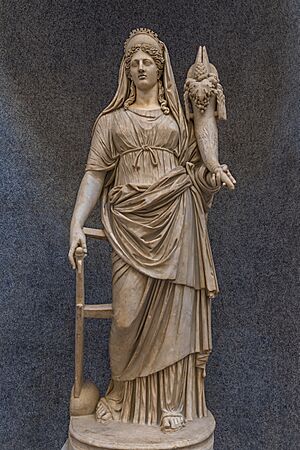Cornucopia facts for kids
The cornucopia (say: kor-noo-KOH-pee-uh) is an ancient symbol. It is also called the horn of plenty. This symbol comes from classical antiquity (ancient Greek and Roman times). It looks like a large horn that is overflowing with fruits, flowers, or nuts. The cornucopia represents having lots of good things, like food and wealth.
Contents
The Cornucopia: A Symbol of Plenty
The word "cornucopia" comes from Latin words meaning "horn of plenty." This special horn has been a symbol of good fortune and lots of food for thousands of years.
What is a Cornucopia?
A cornucopia is shaped like a goat's horn. It is always shown filled to the brim with wonderful things. These can include:
- Fresh fruits
- Bright flowers
- Tasty nuts
- Grains and vegetables
It shows that there is more than enough of everything. It's a sign of prosperity and good harvests.
History of the Cornucopia
The idea of the cornucopia comes from ancient Greek and Roman stories.
- One famous Greek myth tells of the baby god Zeus. He was cared for by a goat named Amalthea. When Amalthea broke one of her horns, Zeus gave it special powers. It could then fill itself with whatever its owner wished for.
- In Roman times, the cornucopia was often shown with goddesses like Fortuna, the goddess of luck, and Abundantia, the goddess of abundance. They carried the horn to show their power to bring good things.
The Cornucopia in Art and Culture
Over time, the cornucopia became a popular symbol in art and celebrations.
- You can see cornucopias in many old paintings and sculptures. They often appear with gods, goddesses, or figures representing peace and wealth.
- In modern times, the cornucopia is still used as a symbol. It is often seen during harvest festivals like Thanksgiving in North America. It reminds people to be thankful for the food and good things they have.
- It also appears in coats of arms and decorations on buildings, showing prosperity and good fortune for a city or family.
The cornucopia is a simple but powerful symbol. It reminds us of nature's gifts and the idea of having plenty for everyone.
Images for kids
-
Louis XVI style armchair with a pair of cornucopia, in the Cabinet Doré de la Reine of the Palace of Versailles
-
Pair of cornucopia in the Opéra national de Lorraine from Nancy
-
Coat of arms of Huntingdonshire, England
-
Europe, forcing the wild bull on its knees and pouring out the cornucopia with the blessings of prosperity, Saarlouis, Town Hall
See also
 In Spanish: Cornucopia para niños
In Spanish: Cornucopia para niños








